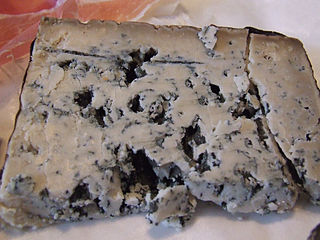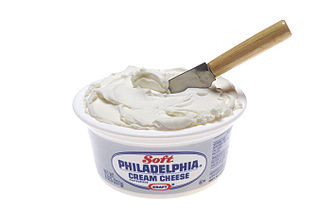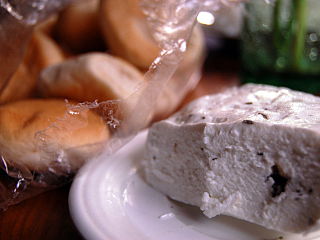
Mozzarella is a semi-soft non-aged cheese prepared by the pasta filata method with origins from southern Italy.

Manchego is a cheese made in the La Mancha region of Spain from the milk of sheep of the Manchega breed. It is aged between 60 days and 2 years.

Curd is obtained by coagulating milk in a sequential process called curdling. It can be a final dairy product or the first stage in cheesemaking. The coagulation can be caused by adding rennet, a culture, or any edible acidic substance such as lemon juice or vinegar, and then allowing it to coagulate. The increased acidity causes the milk proteins (casein) to tangle into solid masses, or curds. Milk that has been left to sour will also naturally produce curds, and sour milk cheeses are produced this way.

Cabrales is a blue cheese made in the artisan tradition by rural dairy farmers in Asturias, Spain. This cheese can be made from pure, unpasteurized cow’s milk or blended in the traditional manner with goat and/or sheep milk, which lends the cheese a stronger, spicier flavor.

Goat cheese, goat's cheese or chèvre is cheese made from goat's milk. Goats were among the first animals to be domesticated for producing food. Goat cheese is made around the world with a variety of recipes, giving many different styles of cheeses, from fresh and soft to aged and hard.

Cream cheese is a soft, usually mild-tasting fresh cheese made from milk and cream. Cream cheese is not naturally matured and is meant to be consumed fresh, so it differs from other soft cheeses such as Brie and Neufchâtel. It is more comparable in taste, texture, and production methods to Boursin and mascarpone. Stabilizers such as carob bean gum and carrageenan are often added in industrial production.

Colby is a semihard orange cheese made from cow's milk. It is named after the city of Colby, Wisconsin, USA, where it was first developed in 1885 and quickly became popular.

Acid-set or sour milk cheese is cheese that has been curdled (coagulated) by natural souring, often from lactic acid bacteria, or by the addition of acid. This type of cheese is technologically simple to produce.

Oaxaca cheese, also known as quesillo and queso de hebra, is a white, semihard, low-fat cheese that originated in Mexico. It is similar to unaged Monterey Jack, but with a texture similar to mozzarella or string cheese.

Cotija is an aged Mexican cheese made from cow's milk and named after the town of Cotija, Michoacán. White in color and firm in texture, its flavor is salty and milky. "Young" cotija cheese has been described as akin to a mild feta, while aged (añejo) cotija is more comparable in flavor to hard, aged cheeses like Parmesan. Cotija softens when exposed to heat, but does not melt. Made between the summer and fall seasons; this cheese is made with milk from local cattle and is salted before the fermentation process. The manufacturing processes of most cheeses in Mexico are still rustic and traditional, similar to the manufacturing process that was used upon its invention. Due to the traditional means of production of dairy products in Mexico some dairy products have a conflicting shelf-life which leads to earlier expiration. However, some studies suggest components in the fermentation of Cotija Cheese are natural preservatives that can extend the shelf-life of Cotija Cheese and other food products as well.
White cheese includes a wide variety of cheese types discovered in different regions, sharing the sole common characteristic of their white hue. The specific type of white cheese can vary significantly depending on the geographical location.

Camel milk is milk from female camels. It has supported nomad and pastoral cultures since the domestication of camels millennia ago. Herders may for periods survive solely on the milk when taking the camels on long distances to graze in desert and arid environments, especially in parts of the Middle East, North Africa and the Horn of Africa. The camel dairy farming industry has grown in Australia and the United States, as an environmentally friendly alternative to cow dairy farming using a species well-adapted to arid regions.

Cheese is a dairy product produced in a range of flavors, textures, and forms by coagulation of the milk protein casein. It comprises proteins and fat from milk. During production, milk is usually acidified and either the enzymes of rennet or bacterial enzymes with similar activity are added to cause the casein to coagulate. The solid curds are then separated from the liquid whey and pressed into finished cheese. Some cheeses have aromatic molds on the rind, the outer layer, or throughout.

Kesong puti is a Filipino soft, unaged, white cheese made from unskimmed carabao milk and salt curdled with vinegar, citrus juices, or sometimes rennet. It can also be made with goat or cow milk. It has a mild salty and tart flavor. When an acidifying agent is used, it resembles queso blanco or paneer. When rennet is used, it resembles buffalo mozzarella. Moisture content can also vary, ranging from almost gelatinous to pressed and firm. It can be eaten as is, paired with bread, or used in various dishes in Filipino cuisine. It is usually sold wrapped in banana leaves.

There are many different types of cheese. Cheeses can be grouped or classified according to criteria such as length of fermentation, texture, methods of production, fat content, animal milk, and country or region of origin. The method most commonly and traditionally used is based on moisture content, which is then further narrowed down by fat content and curing or ripening methods. The criteria may either be used singly or in combination, with no single method being universally used.

Cheeses in Mexico have a history that begins with the Spanish conquest, as dairy products were unknown in pre-Columbian Mesoamerica. The Spanish brought dairy animals, such as cattle, sheep, and goats, as well as cheesemaking techniques. Over the colonial period, cheesemaking was modified to suit the mixed European and indigenous tastes of the inhabitants of New Spain, varying by region. This blending and variations have given rise to a number of varieties of Mexican cheeses. These are most popular in the country, although European cheeses are made, as well. Almost all cheese in Mexico is made with cows’ milk, with some made from goats’ milk. More recently, efforts have been made to promote sheep's milk cheeses. Most cheeses are made with raw (unpasteurized) milk. Cheeses are made in the home, on small farms or ranches, and by major dairy product firms. Between 20 and 40 different varieties of cheese are made in Mexico, depending on how one classifies them. Some, such as Oaxaca and panela, are made all over Mexico, but many are regional cheeses known only in certain sections on the country. Some of the least common are in danger of extinction.

Jocoque or jocoqui is a Mexican dairy product based on fermented milk, from uncertain origins, influenced by Lebanese cuisine.

Argentine cheese is by far the most produced dairy product in the country, making Argentina the second largest cheese producer in Latin America and among the top 10 cheese-producing countries in the world. In addition, Argentina is the Latin American country that consumes the most cheese, with 12 kilos per capita per year. Production is mainly centered in the provinces of Córdoba, Santa Fe and Buenos Aires, in the Pampas region of the central and east-central parts of the country.


















